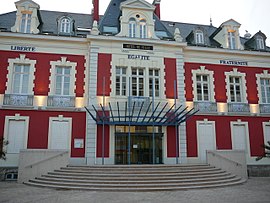Montceau-les-Mines
Montceau-les-Mines | |
|---|---|
 Town hall | |
| Coordinates: 46°40′04″N 4°22′11″E / 46.6678°N 4.3697°E | |
| Country | France |
| Region | Bourgogne-Franche-Comté |
| Department | Saône-et-Loire |
| Arrondissement | Autun |
| Canton | Montceau-les-Mines |
| Intercommunality | CU Creusot Montceau |
| Government | |
| • Mayor (2020–2026) | Marie-Claude Jarrot[1] |
| Area 1 | 16.62 km2 (6.42 sq mi) |
| Population (2021)[2] | 16,831 |
| • Density | 1,000/km2 (2,600/sq mi) |
| Time zone | UTC+01:00 (CET) |
| • Summer (DST) | UTC+02:00 (CEST) |
| INSEE/Postal code | 71306 /71300 |
| Elevation | 274–326 m (899–1,070 ft) (avg. 287 m or 942 ft) |
| 1 French Land Register data, which excludes lakes, ponds, glaciers > 1 km2 (0.386 sq mi or 247 acres) and river estuaries. | |
Montceau-les-Mines (French pronunciation: [mɔ̃so le min]) is a commune in the Saône-et-Loire department in the region of Bourgogne-Franche-Comté in eastern France.
It is the second-largest commune of the metropolitan Communauté urbaine Creusot Montceau, which lies southwest of the city of Dijon.
History
[edit]Montceau-les-Mines is a former mining city. Coal was discovered in the area in the 16th Century. A hamlet called "Le Montceau" developed from this discovery.
"Le Montceau" began to grow after the building of the Canal du Centre, built between 1783 and 1791. A business entity, "Compagnie des mines", started to extract coals in 1833.
The commune was officially established June 24, 1856. as Montceau-les-Mines, a community of 1300 inhabitants, drawn from a territory formed from the villages of Blanzy, Saint-Vallier, Saint-Berain-sous-Sanvignes, and Sanvignes-les-Mines.
A graveyard and a church were built by the principal coal company, a sign of paternalism of mining industry.
Intense social movements took place at the end of the 19th century and at the beginning of the 20th century.
Coal made the city prosperous until 1918. During the War, the production reached 2,786,000 tons. There were about 30,000 inhabitants. After the war, the production started to decrease and stopped in 1992. Economic hardship followed the closing of the mines. By 2017, the population had fallen to about 18,000, unemployment was 21% and many shops of the city had closed.[3]
Population
[edit]Graphs are unavailable due to technical issues. There is more info on Phabricator and on MediaWiki.org. |
| Year | Pop. | ±% p.a. |
|---|---|---|
| 1968 | 27,421 | — |
| 1975 | 28,177 | +0.39% |
| 1982 | 26,925 | −0.65% |
| 1990 | 22,999 | −1.95% |
| 1999 | 20,634 | −1.20% |
| 2007 | 19,548 | −0.67% |
| 2012 | 18,956 | −0.61% |
| 2017 | 18,398 | −0.60% |
| Source: INSEE[4] | ||
Geography, geology and paleontology
[edit]-
Anebos phrixos, an enigmatic insect larva
-
Alanops magnificus, a small freshwater xiphosuran
-
Arthropleura sp., a juvenile of giant millipede
The Bourbince flows northward through the commune and crosses the town.
Exceptional preservation of Late Carboniferous fossil biota characterizes a Lagerstätte at Montceau-les-Mines.[5][6][7][8] It has often been interpreted as a freshwater environment,[6] but some fossils, such as an amphinomidan annelid, [9] and 142 specimens of the xiphosuran Alanops magnificus[10] suggest some marine influence.[11][12][13] In 2024, two juvenile Arthropleura specimens from the Kasimovian (~305 Ma) sediments of Montceau-les-Mines were used to study the animal's head in detail.[14]
See also
[edit]International relations
[edit]Montceau-les-Mines is twinned with:
References
[edit]- ^ "Répertoire national des élus: les maires" (in French). data.gouv.fr, Plateforme ouverte des données publiques françaises. 13 September 2022.
- ^ "Populations légales 2021" (in French). The National Institute of Statistics and Economic Studies. 28 December 2023.
- ^ Nossiter, Adam (December 27, 2017). "Chef Gives Up a Star, Reflecting Hardship of 'the Other France'". The New York Times. Retrieved December 27, 2017.
- ^ Population en historique depuis 1968, INSEE
- ^ Racheboeuf, Patrick R.; et al. (2009). "New malacostracan custacea from the Carboniferous (Stephanian) lagerst?tte of Montceau-les-Mines, France". Journal of Paleontology. 83 (4): 624–629. doi:10.1666/08-171r.1. S2CID 130784496.
- ^ a b Perrier, Vincent; Charbonnier, Sylvain (1 July 2014). "The Montceau-les-Mines Lagerstätte (Late Carboniferous, France)". Comptes Rendus Palevol. 13 (5): 353–367. doi:10.1016/j.crpv.2014.03.002. ISSN 1631-0683.
- ^ Garwood, Russell J.; Dunlop, Jason A.; Giribet, Gonzalo; Sutton, Mark D. (2011). "Anatomically modern Carboniferous harvestmen demonstrate early cladogenesis and stasis in Opiliones". Nature Communications. 2: 444. doi:10.1038/ncomms1458. PMID 21863011.
- ^ Garwood, Russell J.; Sharma, Prashant P.; Dunlop, Jason A.; Giribet, Gonzalo (2014). "A Paleozoic Stem Group to Mite Harvestmen Revealed through Integration of Phylogenetics and Development". Current Biology. 24 (9): 1017–1023. doi:10.1016/j.cub.2014.03.039. PMID 24726154.
- ^ Pleijel, Fredrik; Rouse, Greg W.; Vannier, Jean (2004). "Carboniferous fireworms (Amphinomida : Annelida), with a discussion of species taxa in palaeontology". Invertebrate Systematics. 18 (6): 693. doi:10.1071/IS04003.
- ^ Racheboeuf, Patrick R.; Vannier, Jean; Anderson, Lyall I. (January 2002). "A New Three‐Dimensionally Preserved Xiphosuran Chelicerate from the Montceau‐Les‐Mines Lagerstätte (Carboniferous, France)". Palaeontology. 45 (1): 125–147. doi:10.1111/1475-4983.00230. ISSN 0031-0239.
- ^ Schultze, Hans-Peter (October 2009). "Interpretation of marine and freshwater paleoenvironments in Permo–Carboniferous deposits". Palaeogeography, Palaeoclimatology, Palaeoecology. 281 (1–2): 126–136. doi:10.1016/j.palaeo.2009.07.017.
- ^ Laurin, M.; Soler-Gijón, R. (January 2010). "Osmotic tolerance and habitat of early stegocephalians: indirect evidence from parsimony, taphonomy, palaeobiogeography, physiology and morphology". Geological Society, London, Special Publications. 339 (1): 151–179. doi:10.1144/SP339.13.
- ^ Schultze, Hans-Peter (2013). "The paleoenvironment at the transition from piscine to tetrapod sarcopterygians". New Mexico Museum of Natural History and Science Bulletin. 60: 373–397.
- ^ Lhéritier, M.; Edgecombe, G. D.; Garwood, R. J.; Buisson, A.; Gerbe, A.; Mongiardino Koch, N.; Vannier, J.; Escarguel, G.; Adrien, J.; Fernandez, V.; Bergeret-Medina, A.; Perrier, V. (2024). "Head anatomy and phylogenomics show the Carboniferous giant Arthropleura belonged to a millipede-centipede group". Science Advances. 10 (41). eadp6362. doi:10.1126/sciadv.adp6362.
External links
[edit]









